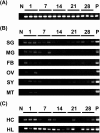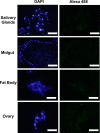The widely distributed hard tick, Haemaphysalis longicornis, can retain canine parvovirus, but not be infected in laboratory condition
- PMID: 25650060
- PMCID: PMC4427740
- DOI: 10.1292/jvms.14-0199
The widely distributed hard tick, Haemaphysalis longicornis, can retain canine parvovirus, but not be infected in laboratory condition
Abstract
Ticks are known to transmit various pathogens, radically threatening humans and animals. Despite the close contact between ticks and viruses, our understanding on their interaction and biology is still lacking. The aim of this study was to experimentally assess the interaction between canine parvovirus (CPV) and a widely distributed hard tick, Haemaphysalis longicornis, in laboratory condition. After inoculation of CPV into the hemocoel of the ticks, polymerase chain reaction assay revealed that CPV persisted in inoculated unfed adult female ticks for 28 days. Canine parvovirus was recovered from the inoculated ticks using a cell culture, indicating that the virus retained intact in the ticks after inoculation, but significant positive reaction indicating virus infection was not detected in the tick organs by immunofluorescence antibody test using a monoclonal antibody. In the case of ticks inoculated with feline leukemia virus, the virus had shorter persistence in the ticks compared to CPV. These findings provide significant important information on the characteristic interaction of tick with non-tick-borne virus.
Figures





Similar articles
-
Transmission of Severe Fever with Thrombocytopenia Syndrome Virus by Haemaphysalis longicornis Ticks, China.Emerg Infect Dis. 2018 May;24(5):868-71. doi: 10.3201/eid2405.151435. Emerg Infect Dis. 2018. PMID: 29664718 Free PMC article.
-
Characterization of overwintering sites of Haemaphysalis longicornis (Acari: Ixodidae) and tick infection rate with severe fever with thrombocytopenia syndrome virus from eight provinces in South Korea.Ticks Tick Borne Dis. 2020 Sep;11(5):101490. doi: 10.1016/j.ttbdis.2020.101490. Epub 2020 Jun 13. Ticks Tick Borne Dis. 2020. PMID: 32723628
-
Identification of tick-borne encephalitis virus in ticks collected in southeastern Hungary.Ticks Tick Borne Dis. 2013 Sep;4(5):427-31. doi: 10.1016/j.ttbdis.2013.04.008. Epub 2013 Jul 13. Ticks Tick Borne Dis. 2013. PMID: 23856473
-
The role of particular tick developmental stages in the circulation of tick-borne pathogens affecting humans in Central Europe. 2. Tick-borne encephalitis virus.Ann Parasitol. 2016;62(1):3-9. doi: 10.17420/ap6201.25. Ann Parasitol. 2016. PMID: 27262951 Review.
-
[Evolution and host variation of the canine parvovirus: molecular basis for the development of a new virus].Berl Munch Tierarztl Wochenschr. 2004 Mar-Apr;117(3-4):130-5. Berl Munch Tierarztl Wochenschr. 2004. PMID: 15046459 Review. German.
Cited by
-
Metagenomic profiling of ticks: Identification of novel rickettsial genomes and detection of tick-borne canine parvovirus.PLoS Negl Trop Dis. 2019 Jan 14;13(1):e0006805. doi: 10.1371/journal.pntd.0006805. eCollection 2019 Jan. PLoS Negl Trop Dis. 2019. PMID: 30640905 Free PMC article.
-
A novel parvovirus, Roe deer copiparvovirus, identified in Ixodes ricinus ticks.Virus Genes. 2019 Jun;55(3):425-428. doi: 10.1007/s11262-019-01661-3. Epub 2019 Apr 3. Virus Genes. 2019. PMID: 30945175
References
-
- Aung K. M., Boldbaatar D., Umemiya-Shirafuji R., Liao M., Tsuji N., Xuenan X., Suzuki H., Kume A., Galay R. L., Tanaka T., Fujisaki K.2012. HlSRB, a Class B scavenger receptor, is key to the granulocyte-mediated microbial phagocytosis in ticks. PLoS ONE 7: e33504. doi: 10.1371/journal.pone.0033504 - DOI - PMC - PubMed
-
- Boldbaatar D., Battur B., Umemiya-Shirafuji R., Liao M., Tanaka T., Fujisaki K.2010. GATA transcription, translation and regulation in Haemaphysalis longicornis tick: analysis of the cDNA and an essential role for vitellogenesis. Insect Biochem. Mol. Biol. 40: 49–57. doi: 10.1016/j.ibmb.2009.12.009 - DOI - PubMed
MeSH terms
LinkOut - more resources
Full Text Sources
Other Literature Sources

